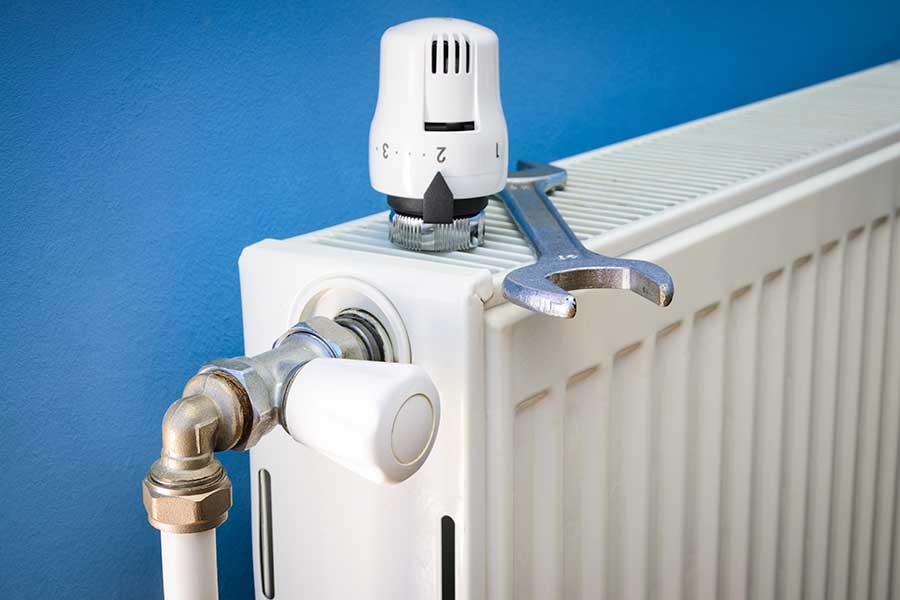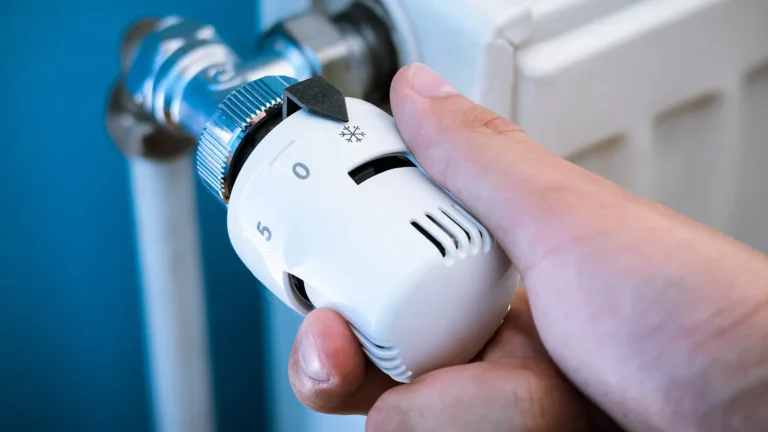In the intricate dance of home heating, radiators play a crucial role in keeping our spaces warm and cozy. Yet, if you’ve ever wondered why certain radiators seem to operate without the ever-watchful eye of a thermostat, you’re not alone.
However, one radiator may not have a thermostat for various reasons. Firstly, if there’s a bypass radiator in the central heating system, it won’t have a Thermostatic Radiator Valve (TRV) to ensure continuous water flow and prevent overheating. Secondly, if the heating system is controlled by a room thermostat, the radiator in that room may lack a TRV to avoid conflicting temperature readings.
Let’s demystify the world of thermostat-free radiators and shed light on the warmth they bring to our living spaces.
| Radiator Type | Description | Common Applications |
| Panel Radiators | Consist of panels with convector fins for efficient heat distribution. | Common in residential and commercial heating systems. |
| Column Radiators | Feature vertical columns for a classic and elegant design, known for high heat output. | Popular for both heating efficiency and aesthetic appeal. |
| Compact Radiators | Designed for smaller spaces, with a compact size and a smooth, flat front. | Ideal for rooms with limited wall space. |
| Towel Radiators | Serve dual purpose of heating and providing a place to warm or dry towels. | Common in bathrooms and spa-like environments. |
| Cast Iron Radiators | Have a vintage design, are durable, and retain heat well even after the system is turned off. | Often chosen for period or traditional home aesthetics. |
| Underfloor Radiant Heating | Heating elements installed beneath the floor for overall room warmth. | Suitable for a variety of spaces; provides uniform heating. |
| Aluminum Radiators | Lightweight, heat up quickly, and have a modern, sleek design. | Energy-efficient; preferred for contemporary interiors. |
| Electric Radiators | Operate independently of central heating systems, providing precise temperature control. | Suitable for spaces where connecting to central heating is not feasible. |
| Low Surface Temperature (LST) | Designed with safety in mind, featuring a casing with a low temperature to prevent burns. | Used in environments with vulnerable individuals. |
| Fan Convectors | Combine traditional radiators with fans to enhance heat distribution, effective in larger spaces. | Common in areas where quick and efficient heat circulation is needed. |
Reasons for the Absence of Thermostatic Radiator Valves (TRVs)

Bypass Radiator Presence:
One common reason is the presence of a bypass radiator in the system. This radiator doesn’t have a Thermostatic Radiator Valve (TRV) because its job is to keep water flowing through the boiler, preventing it from getting too hot and causing damage. It ensures a continuous water flow.
Room Thermostat Control:
If the central heating system is controlled by a room thermostat, the radiator in the room with the thermostat may not have a TRV. This is to avoid conflicting temperature readings. The room thermostat manages the overall house temperature based on that room, and adding a TRV to the radiator could disrupt the thermostat’s control.
Compatibility and Age of the Radiator:
Older radiators, especially those predating the standardization of TRVs in the late 1980s in the UK, might not have these valves. Additionally, if a radiator has an incompatible design or is planned for replacement in the near future, homeowners may choose not to install a TRV.
Budget Constraints:
Installing TRVs on all radiators can be expensive, particularly in homes with numerous radiators. Homeowners might prioritize installing TRVs in frequently used rooms due to budget constraints. However, it’s important to note that investing in TRVs initially can lead to long-term energy savings.
Radiator Valve Replacement:
If a radiator previously had a TRV that malfunctioned or wore out, and the homeowner removed it with the intention of replacement, there might be a temporary absence of it on that specific radiator.
What are thermostatic radiator valves (TRVs) and what do they do?
TRVs, or thermostatic radiator valves, control the temperature in a room by adjusting the flow of hot water to the radiator they are attached to. They provide a simple way to control the heat output of a radiator and the room’s temperature.
How do TRVs work?
TRVs are self-regulating devices with two main parts: the valve head and the valve body. The valve head sits on top of the body. When the room temperature changes, a capsule in the valve head expands or contracts, moving a pin in the valve body. This action either opens or closes the valve, adjusting the flow of hot water to the radiator and controlling the temperature.
How much does a thermostatic radiator valve cost?
A standard pair of TRVs typically costs around £20. Installation costs may vary. If fitting TRVs to multiple radiators requires draining the heating system, it could cost around £350 for a complete installation, while installing just one pair may cost around £120, including the TRVs.
What problems can occur with thermostatic radiator valves?

Common issues include valves sticking or catching, often due to lack of adjustment. If a valve is not working correctly, it may be due to factors like draughts, blockage by furniture, or incorrect positioning. Diagnosing and fixing these problems usually involves simple adjustments or, in extreme cases, replacing the valve head.
FAQ’s
Are thermostatic radiator valves worth it?
Yes, they are. TRVs allow you to set different temperatures in various rooms, providing more control and efficiency. Combining TRVs with heating controls can lead to energy savings of up to 40%, depending on factors like radiator efficiency, insulation, and TRV placement.
Can I install a TRV in every room?
No, While regulations suggest having a minimum set of controls, it’s common to leave one radiator without a TRV. This radiator is usually left permanently switched on. It’s advisable to avoid installing a TRV in the same room as the main wall thermostat to prevent conflicts in temperature control.
Should you have one radiator without a thermostat?
Yes, Standard practice suggests leaving one radiator without a thermostatic radiator valve (TRV) permanently switched on. This radiator often functions as a bypass radiator to maintain the minimum water flow through the system, preventing overheating.
What are Thermostatic Radiator Valves (TRVs)?
TRVs, or thermostatic radiator valves, control air temperature by adjusting the hot water flow to the attached radiator. They provide efficient control over individual room temperatures, contributing to energy savings and comfort.
Why do some radiators not have temperature control?
Radiators may lack temperature control knobs if connected to a solid-fuel boiler or to prevent overheating. Additionally, some homes have a designated bypass radiator to maintain system flow.
Do all radiators have thermostats?
No, Most radiators have a thermostatic radiator valve (TRV) on one side, allowing control over the air temperature in the room. TRVs are an energy-saving tool for adjusting temperatures.
How do you turn on a radiator without a thermostat?
To turn on a radiator without a thermostat, locate the manual valve and turn it counterclockwise until fully open. Additionally, check for the presence of a thermostatic radiator valve (TRV) and adjust it to control temperature.
What is the difference between a radiator and a thermostat?
A thermostat controls the boiler, while radiator valves, like thermostatic radiator valves (TRVs), adjust the heat output of radiators. At least one radiator should be left on continuously to prevent boiler issues.
Do radiators have individual thermostats?
Yes, Radiators can have individual thermostats, either in the form of a central thermostat or thermostatic radiator valves (TRVs) on each radiator. TRVs allow precise control over individual room temperatures.
Why is one radiator always on?
Generally, one radiator, often a bypass radiator, should be left on continuously to maintain the minimum water flow through the system. This ensures proper boiler function and prevents overheating.
How does a thermostat work on a radiator?
Thermostatic radiator valves (TRVs) detect room temperature and adjust the radiator accordingly. The numbered dial on TRVs corresponds to temperature ranges, allowing users to set desired room temperatures.
What is a thermostat in a radiator?
The thermostat in a radiator is a valve that opens or closes based on temperature. It helps regulate the engine’s temperature by isolating it from the radiator until reaching a certain minimum temperature.
Where is the thermostat on a radiator?
Thermostatic radiator valves (TRVs) are typically located on the side of radiators. They resemble cylindrical dials with numbered settings, allowing users to manually adjust the temperature.
What are the two valves on a radiator?
Each radiator has two valves – one controls the hot water entering the radiator, and the other, known as the lockshield valve, balances the system by regulating the heat released from the radiator.
Final Words
The absence of a thermostat on a specific radiator can be attributed to various factors that contribute to the overall efficiency and functionality of a central heating system. Whether due to the presence of a bypass radiator, the influence of a central room thermostat, compatibility and age of the radiator, budget constraints, or a temporary situation awaiting valve replacement.
So, understanding these reasons allows homeowners to make informed decisions about their heating systems.
While the specific circumstances may vary, the goal remains to ensure optimal performance, energy savings, and a comfortable living environment by strategically managing the presence or absence of thermostatic radiator valves.

